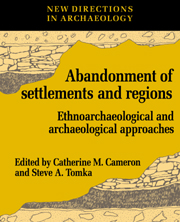Book contents
- Frontmatter
- Contents
- List of figures
- List of tables
- List of contributors
- Acknowledgments
- PART I INTRODUCTION
- PART II REGIONAL ABANDONMENT PROCESSES: ETHNOARCHAEOLOGICAL CASES
- PART III REGIONAL ABANDONMENT PROCESSES: ARCHAEOLOGICAL CASES
- 7 Local abandonments and regional conditions in the North American Southwest
- 8 An assessment of abandonment processes in the Hohokam Classic Period of the Tucson Basin
- 9 Regional settlement abandonment at the end of the Copper Age in the lowlands of west–central Portugal
- PART IV ABANDONMENT PROCESSES WITHIN SITES: ETHNOARCHAEOLOGICAL CASES
- PART V ABANDONMENT PROCESSES WITHIN SITES: ARCHAEOLOGICAL CASES
- PART VI CONCLUSIONS
- Index
7 - Local abandonments and regional conditions in the North American Southwest
Published online by Cambridge University Press: 23 May 2010
- Frontmatter
- Contents
- List of figures
- List of tables
- List of contributors
- Acknowledgments
- PART I INTRODUCTION
- PART II REGIONAL ABANDONMENT PROCESSES: ETHNOARCHAEOLOGICAL CASES
- PART III REGIONAL ABANDONMENT PROCESSES: ARCHAEOLOGICAL CASES
- 7 Local abandonments and regional conditions in the North American Southwest
- 8 An assessment of abandonment processes in the Hohokam Classic Period of the Tucson Basin
- 9 Regional settlement abandonment at the end of the Copper Age in the lowlands of west–central Portugal
- PART IV ABANDONMENT PROCESSES WITHIN SITES: ETHNOARCHAEOLOGICAL CASES
- PART V ABANDONMENT PROCESSES WITHIN SITES: ARCHAEOLOGICAL CASES
- PART VI CONCLUSIONS
- Index
Summary
Introduction
The Four Corners country of North America was the heartland of Anasazi farmers for almost a thousand years before AD 1300. Today, the country is a sparsely populated rural setting. For every farmstead or small town established since the nineteenth century, there are many ancient ruined hamlets and villages in the surrounding fields. With so many ruins so close at hand, the hows and whys of abandonments, the subject of this volume, have been at the center of Southwestern archaeology from its earliest days.
When the field was young and there were few archaeologists and many ruins, the general opinion was that a widespread drought had forced the Anasazi to abandon their homes. By the first decade of this century, as the number of archaeologists rose but the general state of knowledge remained unchanged, A. V. Kidder pronounced Southwestern archaeology to be a “sucked orange” (Kidder 1958:322) and suggested that archaeology abandon the Anasazi. Kidder, one of the founders of the field, left for the lusher environs of lowland Mexico and Central America.
Archaeology did not abandon the Anasazi, however, and the field revived as A. E. Douglass' tree–ring studies began to yield a double harvest of absolute dates and data on paleoclimatic patterns. By 1929, Douglass thought he had identified the cause of “the abandonment” as the Great Drought of the later thirteenth century, AD 1276–99 (Douglass 1929).
- Type
- Chapter
- Information
- The Abandonment of Settlements and RegionsEthnoarchaeological and Archaeological Approaches, pp. 85 - 98Publisher: Cambridge University PressPrint publication year: 1993
- 27
- Cited by



